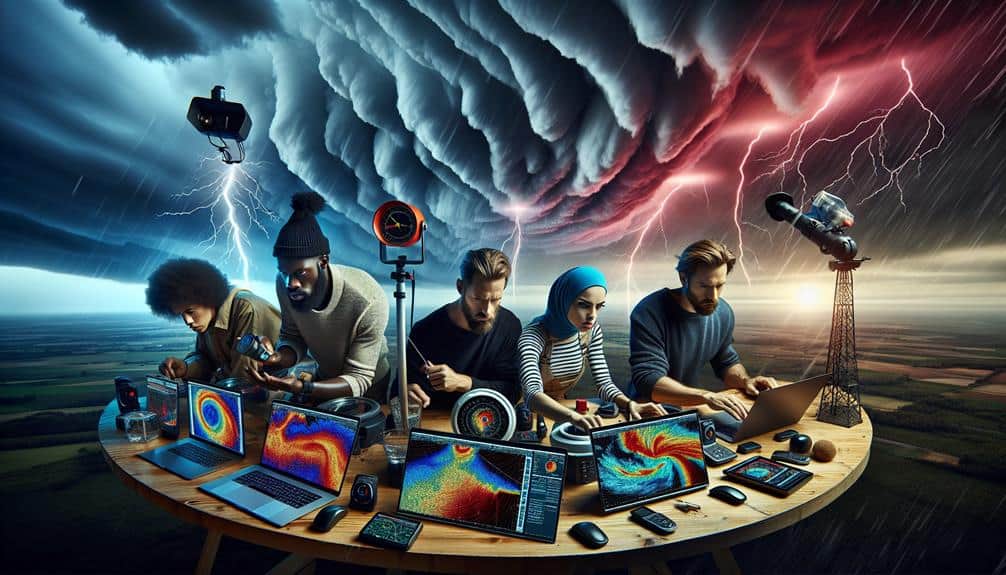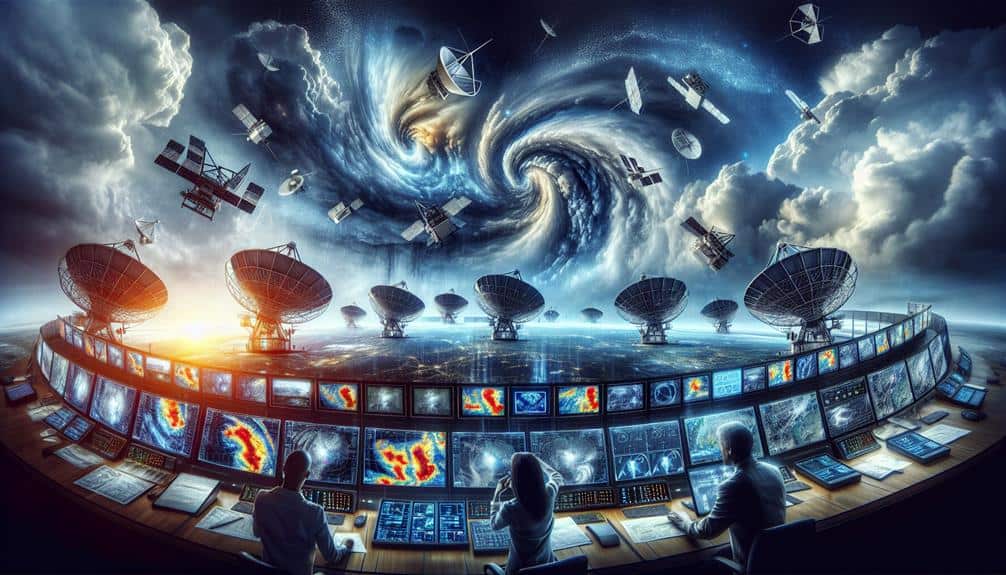Let's start by monitoring trustworthy weather updates from sources like the National Weather Service to get live data. Using reliable radar apps like RadarScope provides accurate storm cell visualizations. Understanding storm patterns through meteorological data helps in precise predictions. Learning basic meteorology, such as atmospheric variables and weather models, equips us to interpret storm information effectively. Finally, following safety protocols, including evacuation plans and lightning precautions, guarantees our safety. These tips provide a solid foundation for beginners in storm tracking, and there's much more to explore in the fields of advanced meteorological science and technology.
Key Points
- Use reliable radar apps like RadarScope for accurate storm tracking and real-time updates.
- Monitor weather updates from trusted sources such as the National Weather Service.
- Understand basic meteorology principles, including atmospheric variables and storm system formation.
- Analyze storm patterns using data from satellite images and weather models.
Monitor Weather Updates
To effectively track storms, we must consistently monitor reliable weather updates from sources like the National Weather Service and advanced meteorological tools. Real-time weather monitoring is important for emergency preparedness, guaranteeing that we can act swiftly and appropriately when a storm approaches. By integrating data from satellite imagery, atmospheric pressure readings, and wind speed metrics, we can make informed decisions that safeguard our freedom and safety.
Staying abreast of updates means we're not solely relying on one data stream. Diversifying our sources improves accuracy. For instance, the National Weather Service offers detailed alerts and forecasts that are continuously refined by cutting-edge algorithms and meteorological expertise. Pairing this with global weather models and localized radar data enhances our understanding of storm trajectories and intensities.
In our quest for freedom, it's essential to understand the significance of these updates. Accurate weather monitoring allows us to devise robust emergency preparedness plans. By analyzing precipitation trends, storm surge probabilities, and historical data, we can anticipate potential impacts and mitigate risks effectively. This proactive approach ensures we're not caught off-guard, granting us the freedom to navigate storm threats with confidence and precision.
Use Reliable Radar Apps
Leveraging dependable radar apps enhances our ability to interpret real-time weather data and make informed decisions about storm preparedness. Radar precision is paramount when tracking storms, and we need apps that provide high-definition radar imagery and precise data updates.
Apps like RadarScope and MyRadar are excellent choices, offering detailed visualizations of storm cells, velocity data, and precipitation intensity. These features enable us to gauge storm development and potential impact with remarkable exactness.
App features play a critical role in our storm tracking endeavors. Advanced features such as storm tracking alerts, custom notifications, and integration with other weather data sources greatly strengthen our situational awareness. For instance, RadarScope's professional-grade radar data can display multiple radar products, such as reflectivity and velocity, which are essential for identifying severe weather phenomena like tornadoes and hail.
Moreover, the user interface of these apps is designed for ease of use without sacrificing the depth of information provided. This empowers us to make quick, yet well-informed decisions about our safety and preparedness.
Ultimately, selecting a dependable radar app with high radar accuracy and inclusive features is a cornerstone in our approach to effective storm tracking and maintaining our desired liberty.
Understand Storm Patterns
Understanding storm patterns involves analyzing meteorological data to identify trends and predict storm behavior accurately. We need to focus on storm formation, which begins when atmospheric conditions create instability. This process often starts with warm, moist air rising and cooling, leading to condensation and cloud formations. By studying these initial stages, we can anticipate the development of severe weather.
We should also examine cloud formations to gain insights into storm potential. Cumulonimbus clouds, for example, indicate a high likelihood of thunderstorms. By observing these clouds and their growth, we can predict storm intensity and trajectory. Additionally, analyzing wind patterns and temperature gradients helps us understand how storms will evolve and move.
Meteorological data, such as satellite images and weather models, provide us with the tools to track these patterns. By integrating data from multiple sources, we can create a detailed picture of storm behavior. This analytical approach allows us to make informed decisions about safety and preparedness, giving us the freedom to act proactively.
Learn Basic Meteorology
Studying fundamental meteorological principles equips us with the knowledge to interpret weather data effectively and forecast storm developments accurately. By grasping the basics of weather forecasting, we can make informed decisions and maintain our autonomy even amid turbulent weather conditions.
First, let's understand the key atmospheric variables: temperature, humidity, wind speed, and atmospheric pressure. These factors interact within the troposphere, creating the dynamic systems we observe daily. Analyzing these elements through tools like barometers, anemometers, and hygrometers allows us to predict changes in weather patterns.
Next, we should look into the formation and movement of storm systems. Cyclones, for example, form when warm, moist air rises and cools, leading to cloud formation and precipitation. By studying the Coriolis effect, we can understand how Earth's rotation influences storm trajectories, an essential aspect of climate science.
Lastly, familiarizing ourselves with weather models—such as the Global Forecast System (GFS) and the European Centre for Medium-Range Weather Forecasts (ECMWF)—enhances our predictive capabilities. These models use algorithms and historical data to simulate future weather scenarios.
Equipped with this knowledge, we gain the freedom to anticipate severe weather, allowing us to prepare adequately and stay informed.
Safety First at All Times

Prioritizing safety, we must always adhere to established protocols and utilize reliable data to minimize risks during storm tracking. Accurate emergency preparedness is paramount. We should create detailed evacuation plans based on storm trajectory data and local geography. This includes identifying primary and secondary routes to safety and ensuring all members of our team are familiar with these plans.
Lightning safety can't be overlooked. Data indicates that lightning strikes are a significant hazard during storms. We must avoid open fields, high ground, and isolated trees. Sheltering options should be pre-determined; substantial buildings with electrical grounding or fully enclosed metal vehicles provide the best protection. Portable lightning detectors and reliable weather apps can offer real-time updates, ensuring we make informed decisions.
Moreover, our storm tracking should rely on multi-source data verification. Utilizing radar imagery, satellite data, and local weather stations can triangulate storm positions accurately, reducing uncertainty. Collaboration with local authorities and meteorological services will enhance our data reliability and improve our response times.
Frequently Asked Questions
What Equipment Do I Need to Start Storm Tracking as a Hobby?
We need essential gear like a durable anemometer, a reliable barometer, and a high-resolution radar app. Beginner resources include online courses and community forums, offering scientific analysis and data-driven insights for accurate storm tracking.
How Can I Join Local Storm Tracking Communities or Groups?
To join local storm tracking communities, we should start by finding resources online through forums and social media groups. Building connections at local meteorology events or workshops can help us network with experienced storm trackers.
Are There Any Certifications Required to Become a Storm Tracker?
We've got great news! No mandatory certification requirements exist to become storm trackers. However, training programs offer invaluable skills and knowledge. Let's explore scientific analysis and data-driven techniques to guarantee our freedom and safety.
What Are the Best Practices for Logging Storm Data?
We prioritize data organization and accuracy by meticulously documenting each observation. Safety precautions are essential; always guarantee personal safety first. Regularly update logs for precise documentation, and use standardized formats for consistency and reliability.
How Can I Contribute My Storm Tracking Data to Research Organizations?
We can contribute our storm tracking data by engaging in citizen science initiatives, promoting data sharing with research organizations. Research collaborations thrive on community involvement, enabling us to support scientific analysis and drive freedom through shared knowledge.

